1993 CHEVROLET CORVETTE brake light
[x] Cancel search: brake lightPage 178 of 370
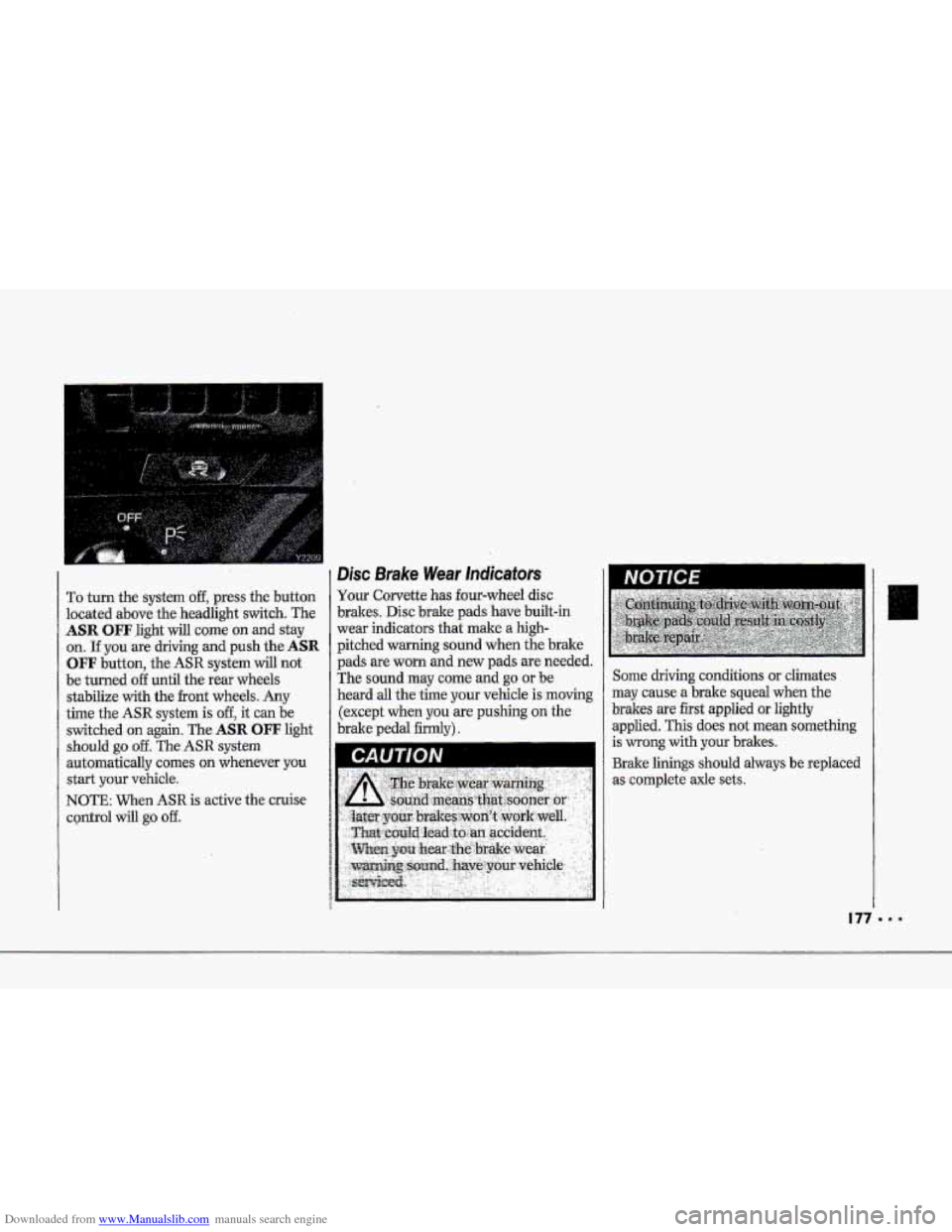
Downloaded from www.Manualslib.com manuals search engine i
T"
$"'
I
r
To turn the system off, press the button
located above the headlight switch. The
ASR OFFlight will come on and stay
on. If you are driving and push the ASR
OFF button, the ASR system will not
be turned off until the rear wheels
stabilize with the front wheels.
Any
time the ASR system is off, it can be
switched.
on again. The ASR OFF light
should
go off. The ASR system
automatically comes
on whenever you
start your vehicle.
NOTE: When ASR is active the cruise
CQntrOl will go off.
Disc Brake Wear lndicators
Your Corvette has four-wheel disc
brakes. Disc brake pads have built-in
wear indicators that make
a high-
pitched warning sound when the brake
pads are worn and new pads are needed.
The sound may come and
go or be
heard
aIl the time your vehicle is moving
(except when you
are pushing on the
brake pedal firmly). Some
driving conditions or climates
may cause a brake squeal when
the
brakes are first applied or lightly
applied. This does not mean
something
is wrong with your brakes.
Brake linings should always be replaced
as complete axle sets.
Page 181 of 370
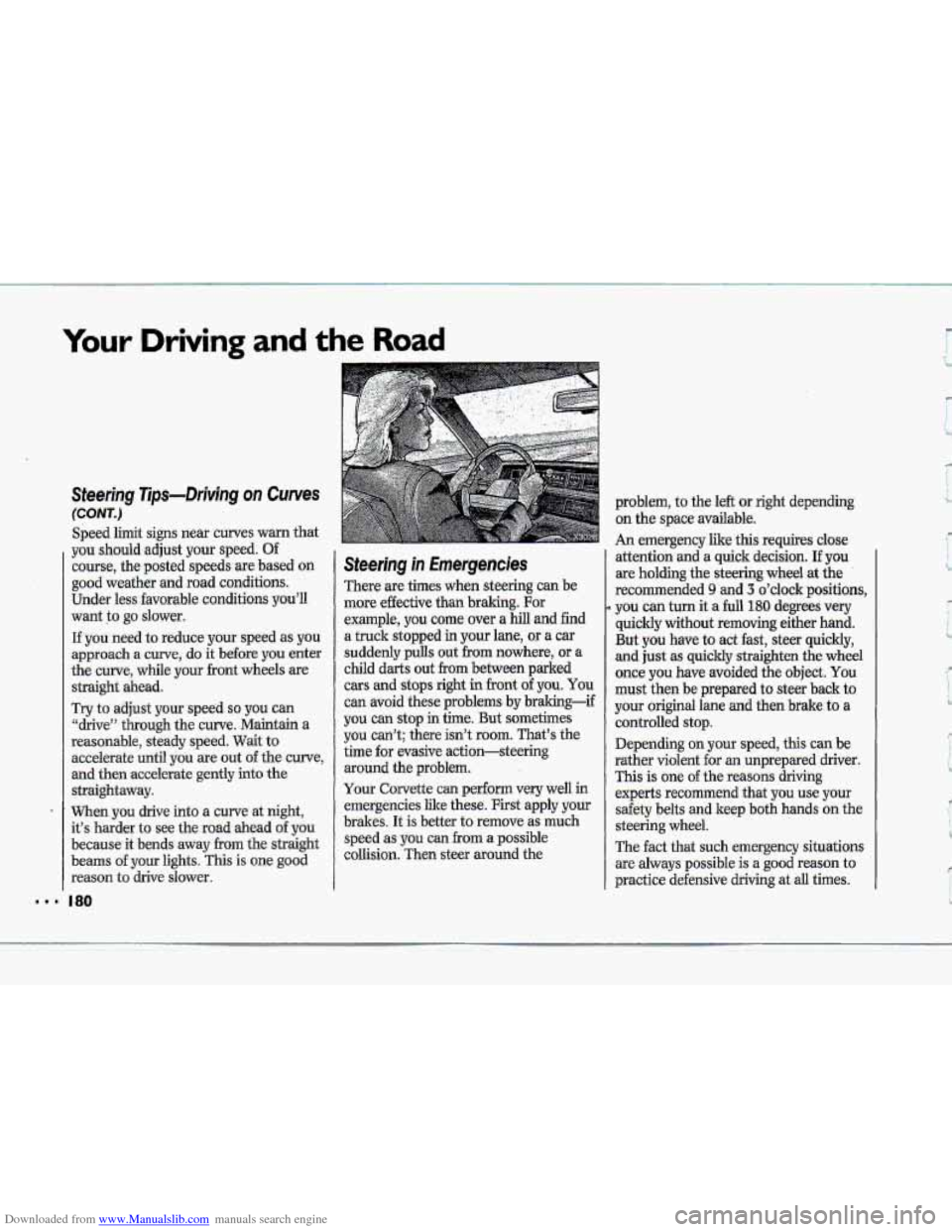
Downloaded from www.Manualslib.com manuals search engine ..I
Your Driving and the Road
’I
Steering Tips-Driving on Curves
(CONT.)
Speed limit signs near curves warm that
you should adjust your speed.
Of
course, the posted speeds are based on
good weather and road conditions.
Under less favorable conditions you’ll
want to
go slower.
If you need to reduce your speed as you
approach
a curve, do it before you enter
the curve, while your hont wheels are
straight ahead.
Try
to adjust your speed so you can
Wive” through the curve. Maintain a
reasonable, steady speed. Wait to
accelerate until you are out
of the curve,
and then accelerate gently into the
straightaway.
When you drive into
a curve at night,
it’s harder to see the road ahead
of you
because it bends away
from the straight
beams
of your lights. This is one good
reason to drive slower.
I80
Steering in Emergencies
There are times when steering can be
more effective than braking. For
example,
you come over a hill and find
a truck stopped
in your lane, or a car
suddenly pulls out
€ram nowhere, or a
child darts out from between parked
cars and stops right in front of you. You
can avoid these problems by braking-if
you can stop in time. But sometimes
you can’t; there isn’t
room. That’s the
time for evasive action-steering
around the problem.
Your Corvette
can perform very well in
emergencies like these. First apply your
brakes. It is better
to remove as much
speed as you can
from a possible
collision. Then steer around the
9
problem, to the left or right depending
on the space available.
An emergency like this requires close
attention and a quick decision.
If you
are holding the steering wheel at the
recommended
9 and 3 o’clock positions,
you can turn it a full 180 degrees very
quickly without removing either hand.
But you have to act fast, steer quickly,
and just as quickly straighten the wheel
once
you have avoided the object. You
must then be prepared to steer back to
your original lane and then brake to a
controlled stop.
Depending on your speed, this can be
rather violent for an unprepared driver.
This is one of the reasons driving
experts recommend that you use your
safety belts and keep both hands
on the
steering wheel.
The fact that such emergency situations
are always possible is
a good reason to
practice defensive driving at
all times.
Page 183 of 370
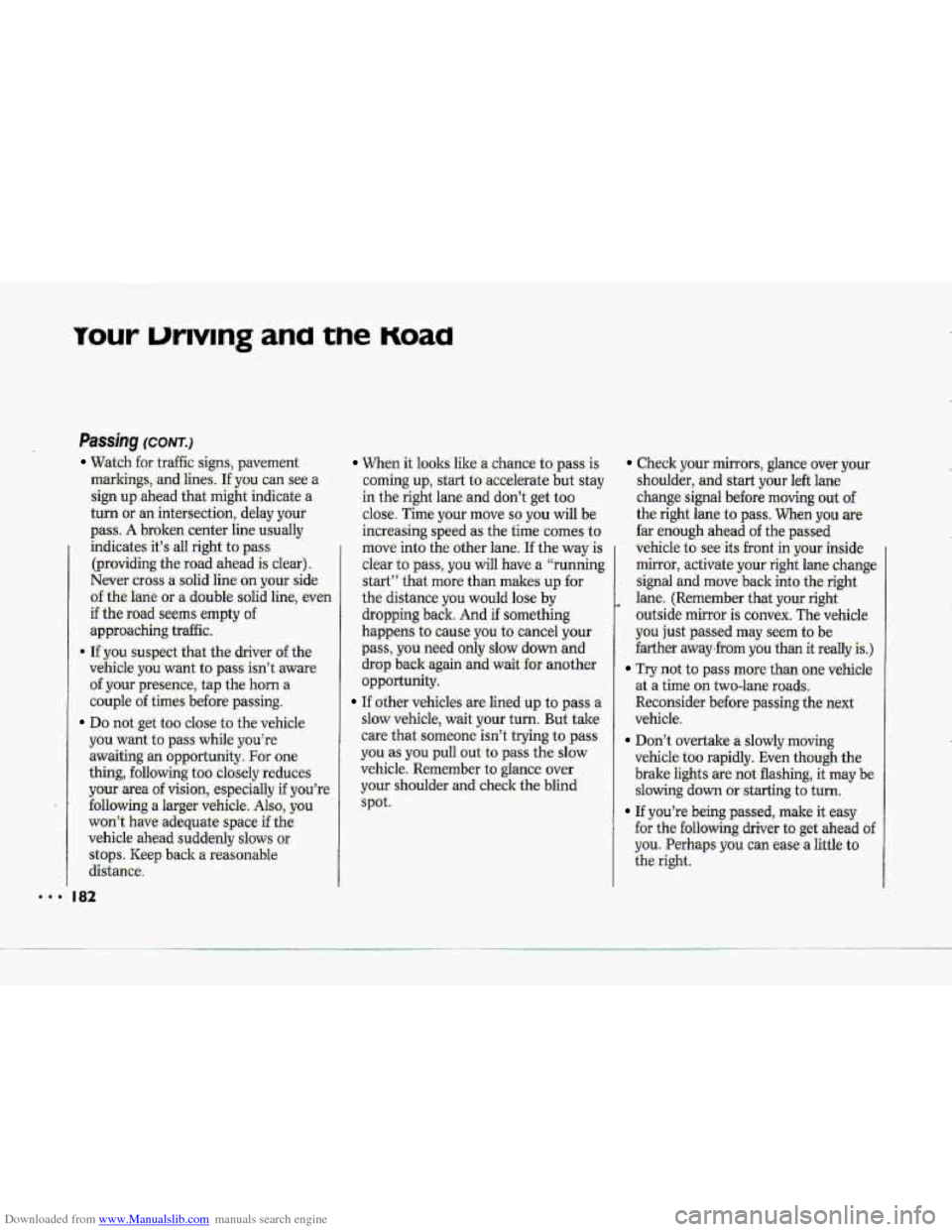
Downloaded from www.Manualslib.com manuals search engine row urlvrng ana tne noaa
‘I
PaSShg (COW.)
Watch for traffic signs, pavement
markings,
-and lines. If you can see a
sign
up ahead that might indicate a
turn
or an intersection, delay your
pass. A broken center line usually
indicates -it’s all right
to pass,
(providing the road ahead
is clear).
Never cross a solid line on.your side
of the lane or a double solid line, even
if the road seems empty of
approaching traffic.
* If you suspect that the- driver of the
vehicle
you want to. pass isn’t .aware
of-your presence, tap the horn a
couple of times before. passing.
Do not.get too close- to the vehicle
you want
to pass while you’re
awaiting an opportunity. For one
thing, following tQo closely reduces
your area
of vision, especi-ally if you’re
following
a larger vehicle. Also, you
won’t have adequate space if the
vehicle
,ahead suddenly slows dr
stops. Keep back a- reasonable
distance.
I 82
When it 1cr.oks like a chance to:pass is
.doming up, start to-accelerate but stay
in the- right lane and don’t -get- too
close. Time your move so, you will be
increasing speed as’the time comes to
move into the other
lane.3 the. way is
clear to pass, you will have a “running
start’” that
more than makes up fix
the distance you would lose by
dropping back. And
if something
happens to Cause you to cancel your
pass, you need only slow down and
drop back again and wait for another
opportunity.
If other vehicles .are lined up to pass a
slow vehicle, wait your turn. But: take
care that someone- isn’t trying to pass
you as you pull out to pass the slow
vehicle. Remember to glance, over
your shoulder andxheck the blind
spot.
Check your mirr-ors, glance over your
shoulder, aad start your left lane
change-,signal before
,moving aut of
the right lane to pass. When you are
far enough ahead of the. passed
vehicle to see-its front in your inside
mirror, activate.your right lane ,change
signal
and move back into the right
lane; (Remember that-your right
0-utside mirror is-convex. The vehicle
you just passed ‘may seem to be
farther away+from you than it redly
is.)
Try n0t.t.o pass more than one vehicle
at a time on two-lane roads.
Reconsider before passing the next
vehicle.
.vehicle too rapidly. Even though the
brake lights. are not flashing, it may be
slowing dawn or starting to turn.
If you’re- being passed, make it easy
for the following. driver to get ahead
of
you. Perhaps you can ease. a little to
the right;
Don’t overtake a slowly .m,oving
Page 193 of 370
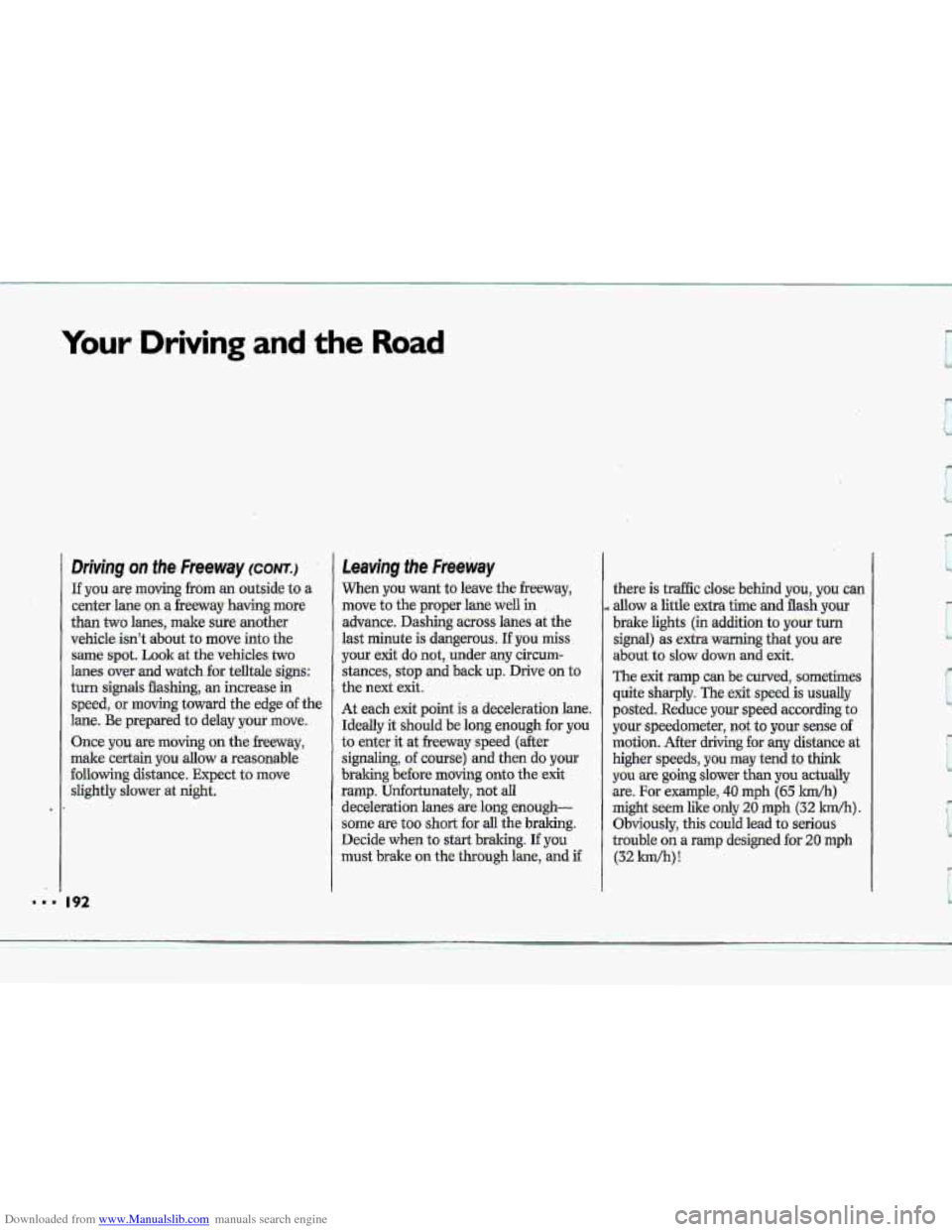
Downloaded from www.Manualslib.com manuals search engine Your Driving and the Road
Driving on the Freeway (CONTJ
~fyou are moving from an outside to a
center lane. on a freeway having more
than two lanes, make sure another
vehic1e;isn't about to move
into the
same spot. Look at the 'vehicles two
lanes over and watch for telltale signs:
turn
signals flashing? an increase in
speed, or
moving toward the edge-of the
lane. Be prepared to delay
your move.
Once you are moving on the freeway,
make certain you allow a reasonable
following distance. Expect
to move
slightly slower at night.
Leaving the Freeway
When you want to leave the freeway,
move to the proper lane well in
advance. Dashing across lanes at the
last minute is dangerous.
If you miss
your exit do not,.under any circum-
stances,
stop and back up. Drive on to
the next
exit.
At each exit point is a deceleration lane.
Ideally it
should be long enough for you
to enter it at freeway speed
(after
signaling, of course) and then do your
braking before
moving onto the ,exit
ramp. Unfortunately, not all deceleration lanes are
long enough-
.some are too short for all the braking.
Decide when
to start braking. If you
must brake on the.through lane, and if
there is traffic close behind you, yau can
allow a little extra tirrie and flash your
brake lights (in addition to your turn
signal)
as extra warning that you are
about to slow down and exit.
The exit ramp
can be curved, sometimes
quite sharply. The exit speed
is usually
posted. Reduce
your speed according to
your speedometer, not-to your sense of
motion. After driving.for any distance at
higher speeds,
you may tend to- think.
you -we going slower than you actually
are. For example,
40 mph (65 I&)
might seem like only 20 mph (32 Wh) .
Obviously, this could lead to serious
trouble on a
ramp designed for 20 rnph
(32 W)!
P
be
Page 199 of 370
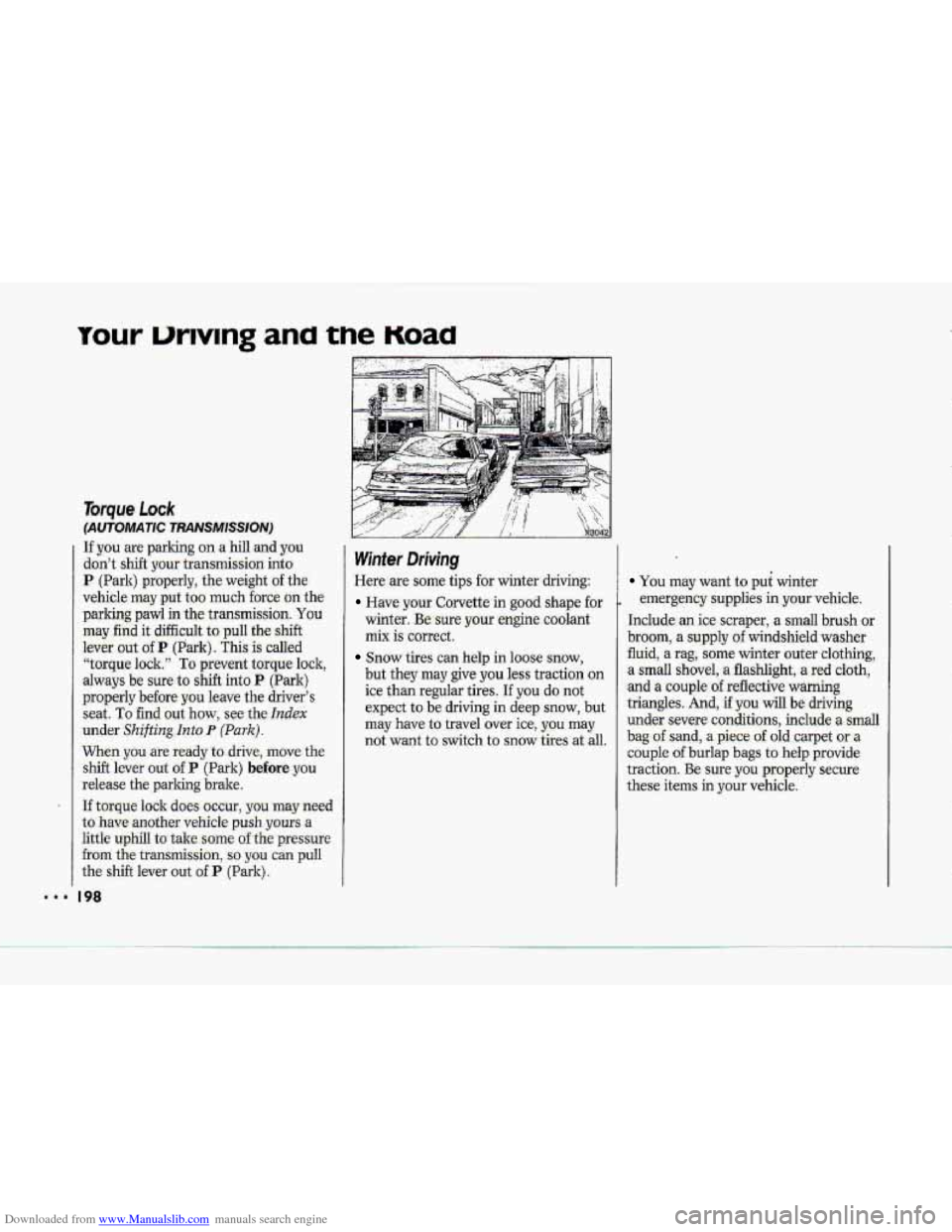
Downloaded from www.Manualslib.com manuals search engine your urlvlng ana tne Koaa
Torque Lock
(AUTQMATIC TRANSMISSION)
If you are parking on a hill and you
don’t shift your transmissian into
P (Park) properly, the weight of the
vehicle may put
too much force on the
parking pawl in the transmission. You
may find it difficult to pull the shift
lever out of
P (Ihrlr). This is called
“torque
lock.” To prevent torqu’e lock,
always
be sure to shift into P (Park)
properly before you leave the driver’s
seat.
To find out how, see the Index
under Shifting Into P (Park).
When you are ready to drive, move the
shift lever out
of P (Park) before you
release the parking brake.
If torque lock does occur, you may need
to. have another vehicle push yours a
little uphill to take some of-the pressure
from the transmiss.ion, ‘so you can pull
the
shifi lever out of P (Park).
I98
Winter Driving
Here are some tips for winter driving:
Have your Corvette in good shape for
winter.
Be sure your engine coolant
mix is correct.
Snow tires can help in loose snow,
but they may give you less traction on
ice than regular tires. If you do not
expect to be driving
in deep snow, but
may have
to travel over ice, you may
not want to switch to
snow tires at .all.
YOU may want to put winter
emergency supplies in your vehicle.
Include
an ice scraper, a small brush or
broom, a supply of windshield washer
fluid, a rag, some winter outer clothing,
a small shovel, a flashlight, .a red cloth,
and a couple of reflective warning
triangles. And, if-you will be driving
under severe conditions,
include a small
bag of sand, a piece of old carpet or a
couple of burlap bags to help provide
traction. Be sure you properly secure
these items in your vehicle.
Page 272 of 370
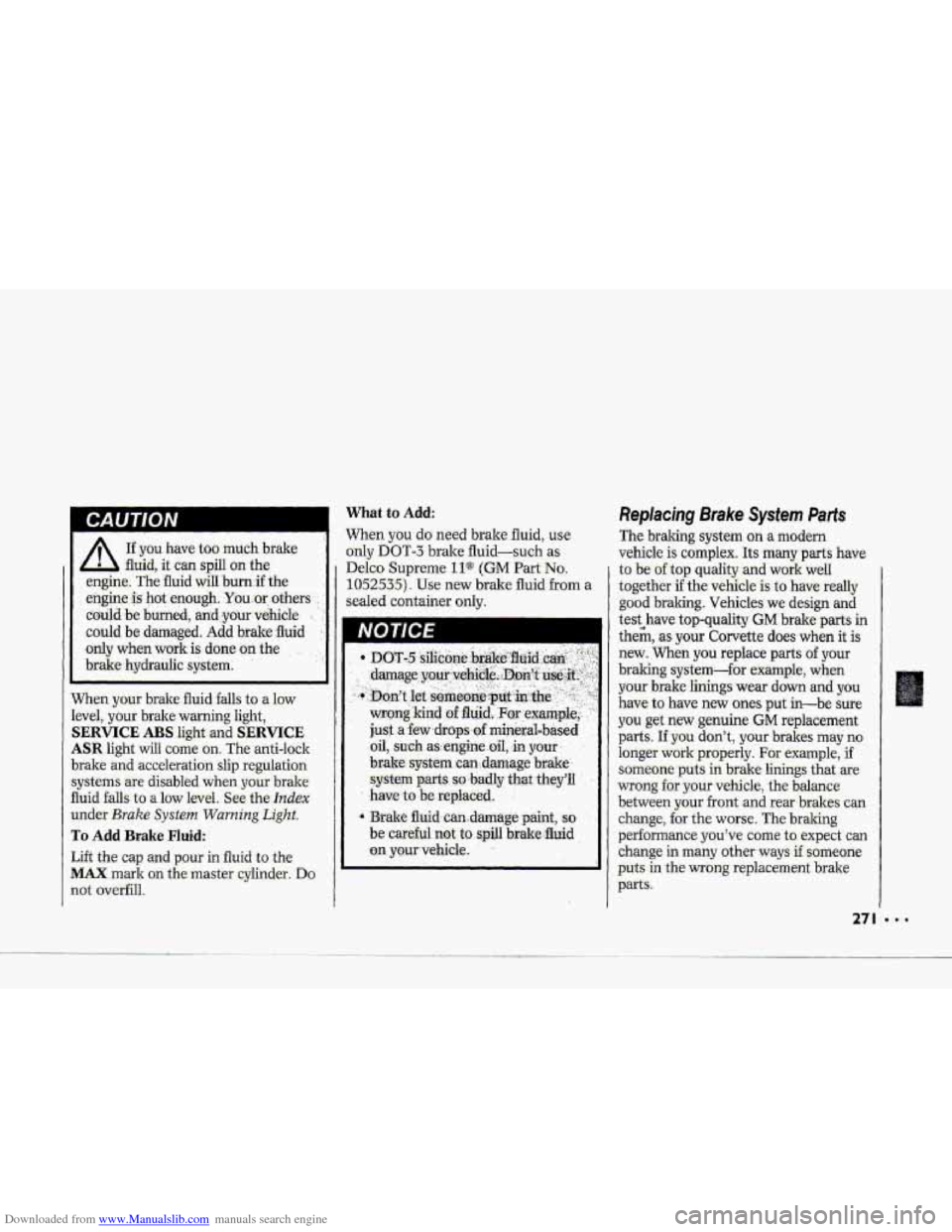
Downloaded from www.Manualslib.com manuals search engine c
.-
WETen your brake fluid falls to a.low
level,
your brake warning light,
SERVICE ABS light and SERVICE
ASR light will come on. The- anti-lock
brake and .acceleration
slip regulation
systems are disabled when your brake
flu.id falls to
it low level. See thedndex
under
Brake System Warning Light;
To Add Brake Fluid:
Lift the cap and pour in fluid to the
MAX mark on the master cylinder. Do
not oveffiI1.
&%at to Add:
When you do need brake fluid, use-
)nly
DOT-3 brake fluid-such as
lelcrr Supreme 1P (GM Part No.
.052535). Use new brake fluid from a
'eded. container only.
NOTlCE
Replacing Brake System Parts
The braking system on a modern
vehicle is
complex. Its many parts have
to be
of top quality -and work well
together if the vehicle is to haye really
good braking. Vehicles we design and
test have top-quality GM brake-parts in
the&, as
your Corvette does when it is
new. When you replace parts of your
braking 'system-for example, when
your brakelinings wear down and you
have to have new ones put in-be sure
you get new genuine GM replacement
parts. If.you don't, your brakes may no
longer work properly. For example, if
someone.puts
in b.r&e linings that are
wrong for your vehicle, .the balance
between your
front and rear brakes can
change, for the worse. The braking
performance
you've come to expect can
change in many other ways if.-someone
puts
in the wrong replacement brake
parts.
27 I
Page 337 of 370
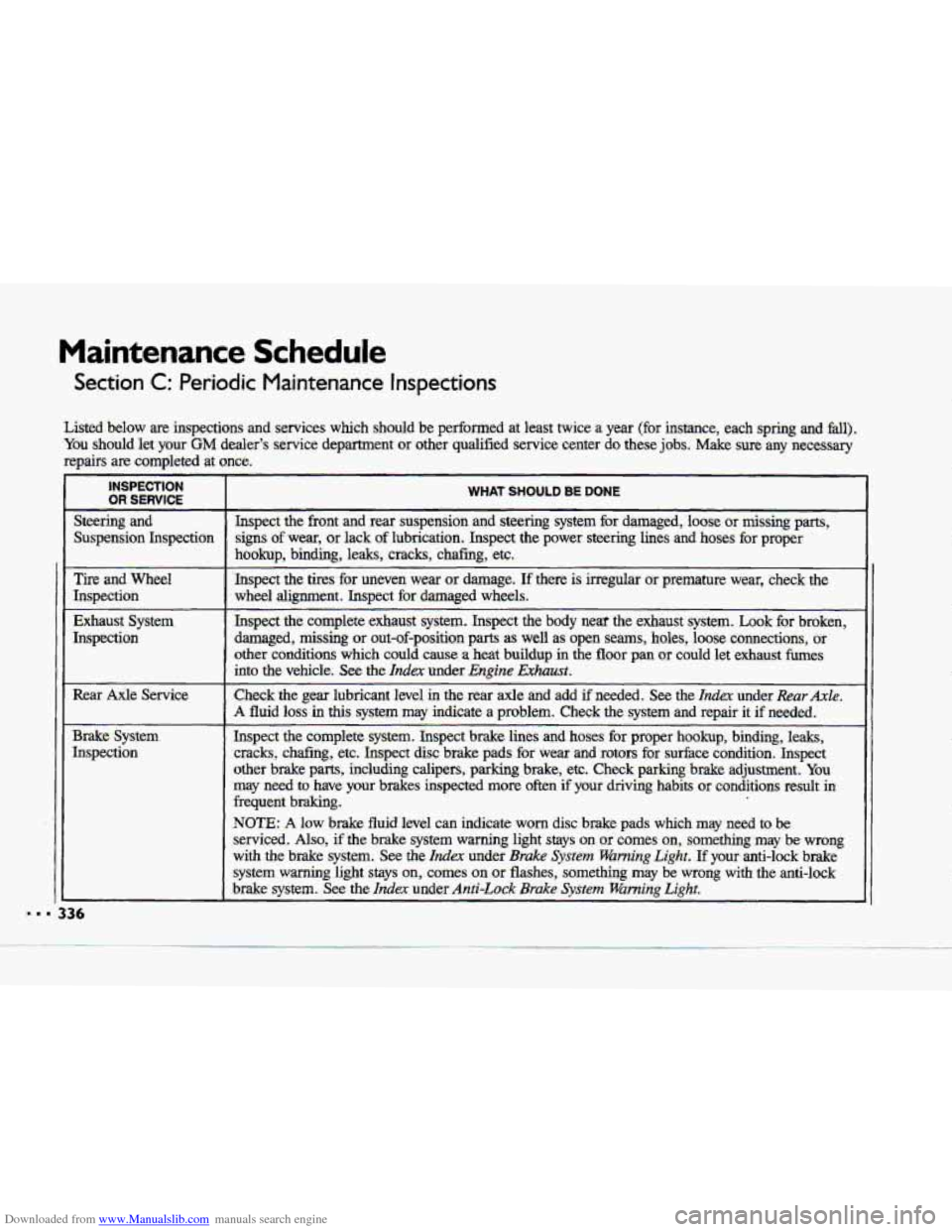
Downloaded from www.Manualslib.com manuals search engine Maintenance Schedule
Section C: Periodic Maintenance Inspections
Listed below are inspections and services which should be performed at least twice a year (for instance, each spring and fall).
You should let your- GM dealer's service department or other qualified ssvj,cg [email protected] do these j-obs. Make sure any necessary
repairs are completed
at once.
INSPECTION
OR SERVICE
Steering and
Suspension Inspection
Tire and Wheel
Inspection
Exhaust System
Inspection
~-
Rear Axle Service
Brake System
Inspection
WHAT SHOULD BE DOME
Inspect. the front and rear susp-ension and steering system for damaged, loose or missing parts,
signs of wear, or lack of lubrication. Inspect the power steering lines and hoses. for proper
hookup,
bindmg-, leaks, cracks, chafing, etc.
Inspect the tires for uneven wear or damage. If there is irregular or premature wear, check the
wheel alignment. Inspect for damaged wheels.
Inspect the complete exhaust system. Inspect the
body neat the exhaust system. Look for broken,
damaged, missing or out-of-position parts as well as open seams, holes, loose connections, or
other conditions which could cause a heat buildup in the floor pan or could let exhaust fumes
into the- vehicle.
See the Index under Engine Exhaust.
Check:the gear lubricant leve1.h the rear axle and add if needed. See the Index: under Rear Axle.
A fluid loss in this system;may indicate a problem. Check the system and repair it if needed.
Inspect the complete system. Inspect brake lines and
hoses for proper hookup, binding, leaks,
cracks, chafing, etc. Inspect disc brake pads for wear and rotors for surface condition. Inspect
-other brake parts, .hcluding calipers, parking brake, etc. Check parking brake adju\
stment. You
may need
to have your brakes inspected more often if your driving habits or conditions result in
frequent braking.
NOTE:. A low brake fluid level can indicate worn disc brake pads which may need to be
serviced.
Also, if 'the brake system warning light stays on or comes on, something may be wrong
with .the brake system. See the Index under Brake System Warning Light. 'If your anti-lock brake
systemwarning light stays on, comes on or flashes, something may be wrong with the anti-lock
brake system. See the Index under Anti-Lock Brake System Warning Light.
Page 358 of 370
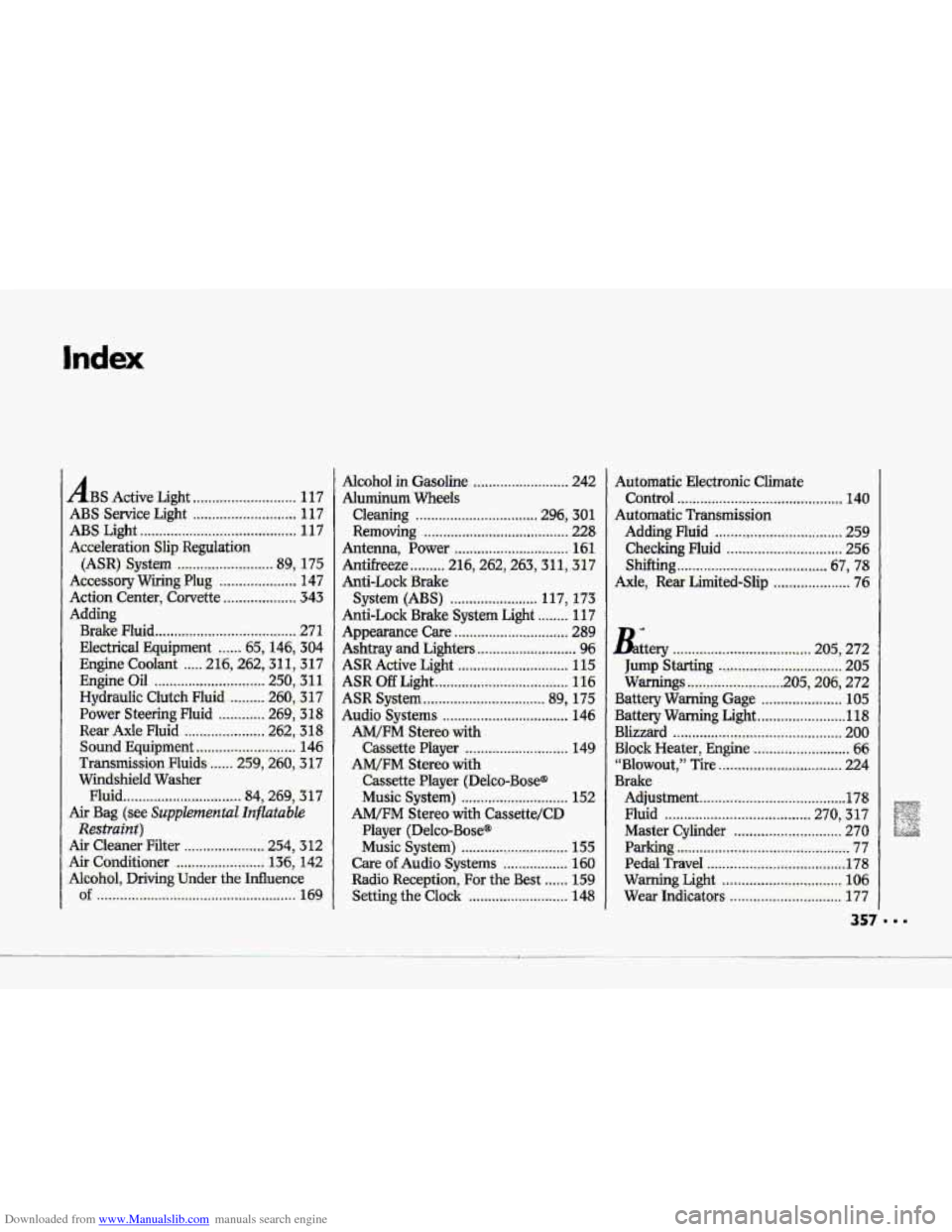
Downloaded from www.Manualslib.com manuals search engine 1-
-
ABS Active Light ........................... 117
ABS Service Light ........................... 117
ABS Light ......................................... 117
Acceleration Slip Regu’laticin
(ASR) System .......................... 89,. 175
Accessory Wiring . Plug .................... 147
Action Center, Corvette ................... 343
Adding
Brake Fluid
.......... ........... ............ . 27 1
Electrical Equipment ...... 65, 146, 304
Engine Coolant ..... 216, 262,311,3.27
Engine Oil ............................... 250, 31 1
Hydraulic Clatch Fluid’ ......... 260, 3 17
Power Steeting Fluid ............ 269, 318
Rear Axle Fluid ..................... 262, 318
Sound Equipment ........................... 146
Transmission Fluids. ..... 25.9,260, 317
Windshield Washer
Fluid ............................... 84, 269, 3 17
Air .Bag (see Supplemental Inflatable
AirCieaner Filter ..................... 254, 312
.Air Conditioner ....................... 136., ‘142
Alcohol, .Driving Under thi Influence
of ..................................................... 169
Restraint)
Alcohol in Gasoline ......................... 242
Aluminum Wheels
Cleaning
................................ 296. 301
Antenna, Power ............................... 161
Antifreeze ......... 216, 262, 263, 311., 317
Anti-Lock Br.& e
Removing ....................................... 228
System (ABS) ....................... 117? 1-73
Anti-Lock Brake System Light ........ 117
Ashtray and Lighters .......................... 96
ASR Off Light .............................. .... 116
ASR System ................................. 89, 175
Cassette Playek ........................... 149
Music System) ............................ 152
Music System) ............................ 155
Appearance Care .............................. 289
ASR Active Light ............................. 115
Audio Systems ................................. 146
AM/FM Stereo with
.AM/F M. Stereo-with
Cassette Player
(Delco-Base@
AM/FM Stereo with CassetteKD
Player (Delco-Bose*
Care of Audio Systems ................. 160
-Radio Reception. For the Best ...... 159
Setting.the Clock ............................ I48
Automatic Electroriic Climate
Aptomatic
Transmission
Control ........................................... 140
Adding Fluid ................................. 259
Axle, Rea Liniited-Slip ....................... 76
Checking Fluid ................................. 2.56
Shifting., ....................................... 67, 78
&ry ..................................... 205, 272
Jump Starting ..........................?........ 205
Warnings .......................... 205, 206, 272
Battery Warning . Gage ..................... 105
Battery Warning Light ....................... 118
Blizzard ............ ..i.. ........................... 200
Block Heater, Engine ......................... 66
“Blowout, ” Tire .................................. 224
Brake AdjustmenL
..................................... 178
Fluid ...................................... 270, 317
Master Cylinder ............................ 270
Parking ............................................. 77
Pedal Travel .................................... 178
Warning Light .................................. 106
Wear Indicators .............................. 177
351 I..
.